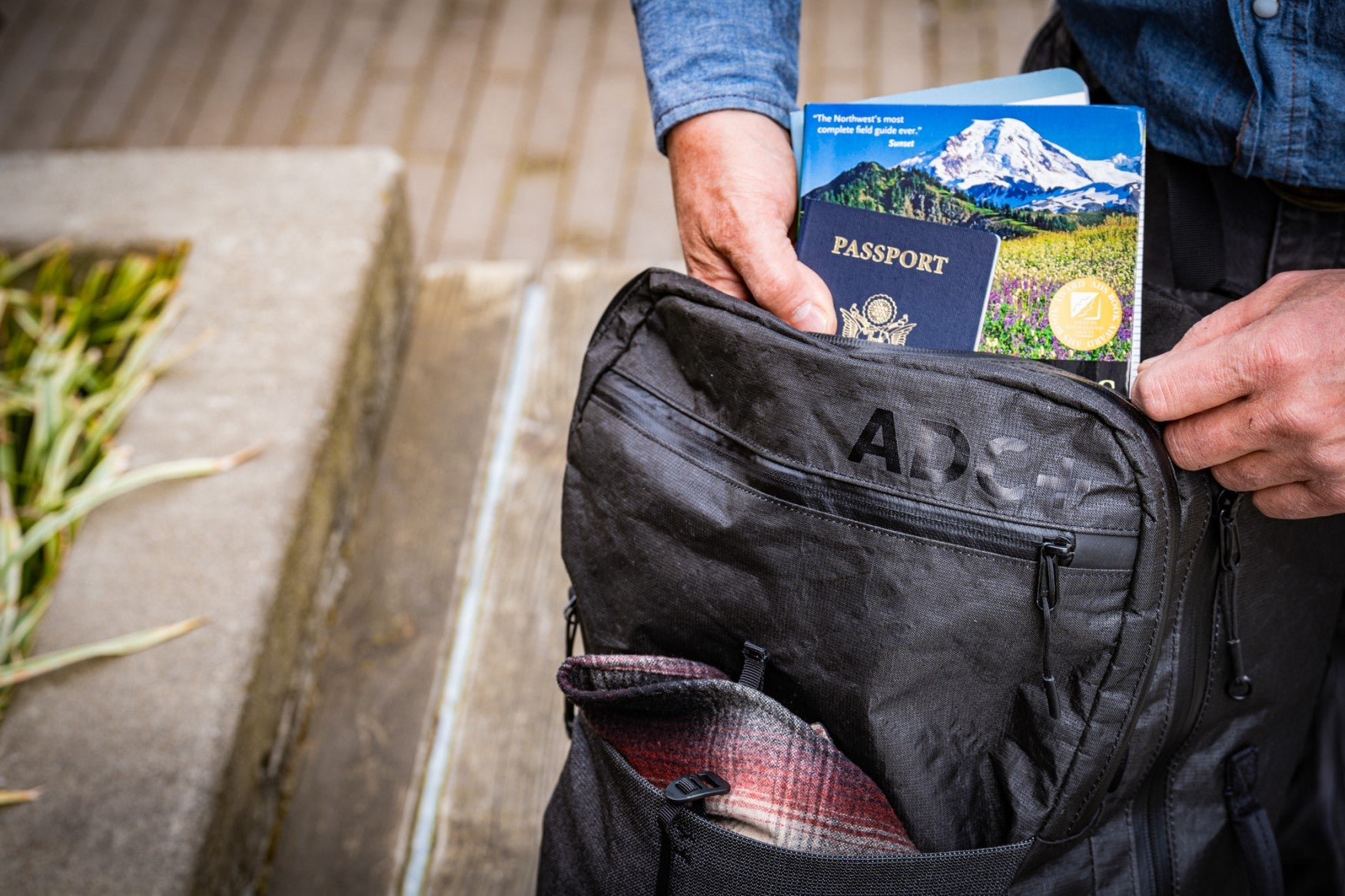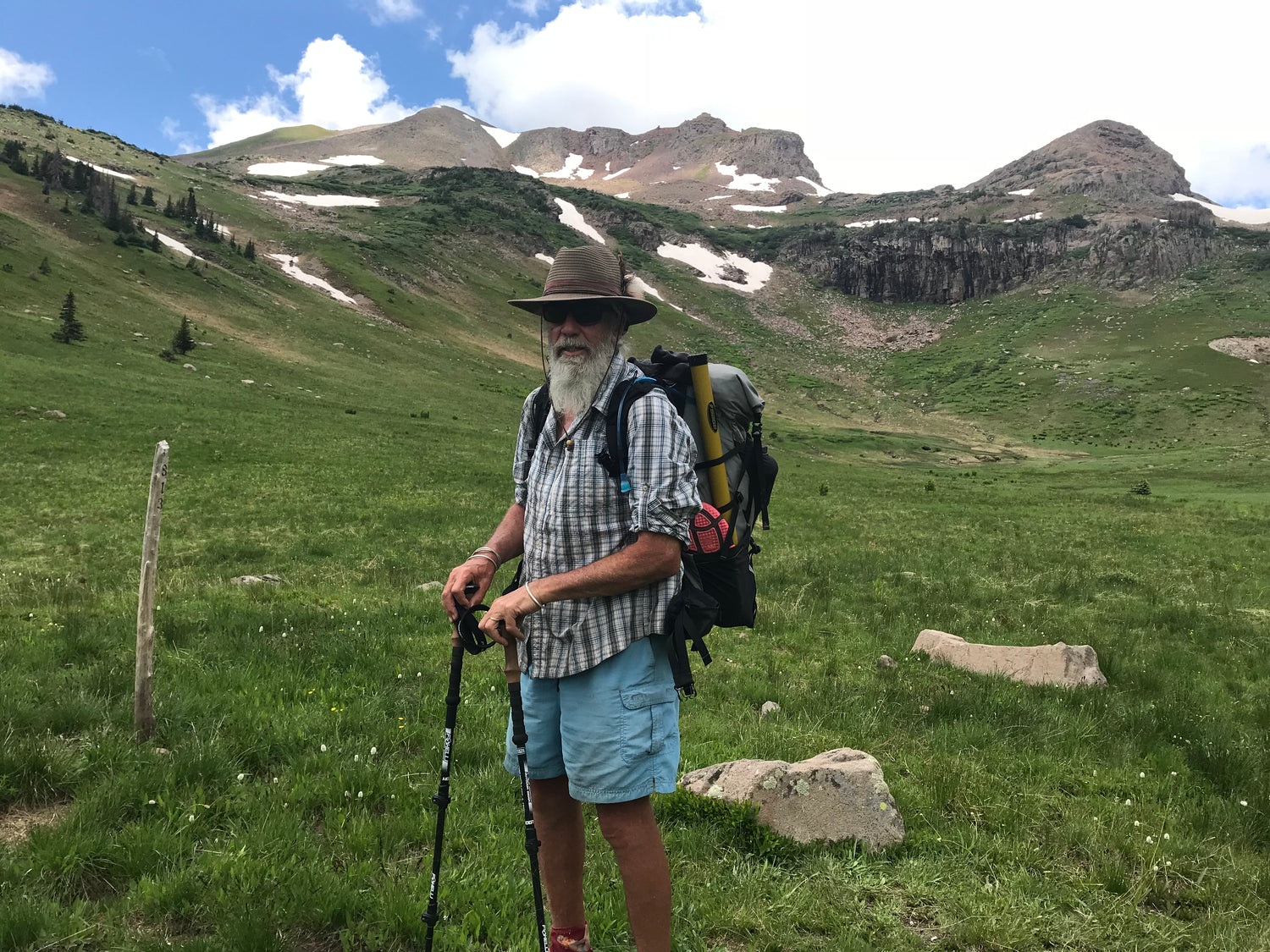
The San Juan Mountains of Colorado Photo by Hawkeye Johnson
For the past four years instead of traveling somewhere to go for a long hike, I’ve started walking out my door into the rugged San Juan Mountains of southwestern Colorado. This summer I hiked a 400-mile loop from my home in Telluride into the Weminuche Wilderness and the South San Juan Wilderness using a combination of existing trails but generally followed the Continental Divide Trail (CDT) south to Cumbres Pass and then returning home. I resupplied in the Colorado towns of Silverton, Lake City, Pagosa Springs and Chama, New Mexico. A map of this route can be found at https://gohawkeye.org/2019-fundraiser-hike/ . I have named it the GoHawkeye San Juan Trail (GST). I packed a fly fishing rod and a good book and was very gratified to spend 37 days walking this path and fishing some streams and lakes along the way. This trail has an average elevation of 11,000 feet and encompasses the vast San Juan Volcanic field which contains 22 calderas and is the site of the largest volcanic eruption known to man.

The snow-covered San Juan Mountains in mid-July of 2019 Photo by Hawkeye Johnson
The adventure began July 17 and the high mountains were still covered in snow. I was glad I had micro spikes on my feet and self-arrest skills. Filmmaker Paul Bikis joined me for the first couple of days in the steep terrain between Telluride and Silverton, and he was good company in the frozen basin around Columbine Lake and on the way to Ohio Peak. After a quick resupply in Silverton, I hiked north on the CDT to Wager Gulch then resupplied in Lake City. Next, I headed east on the Lost Trail to the Rio Grande Reservoir where some fishing buddies brought me a resupply box, fresh food and good times. The Squaw Creek Trail climbed south into the Weminuche Wilderness to link up with the CDT again on which I continued on south for 50 miles until Wolf Creek Pass.
During this monsoon period, there were thunderstorms, lightning, and hail at some point almost every day and my SMD Silver Shadow Carbon Umbrella was quite handy for protection from hail or when wedged into a tree for a hands-free lunch out of the rain. It barely sprang at this elevation and I encountered large patches of snow, some impassable, so I would have to find a way around. The wildflowers were just emerging and It was rare to see any other hikers or wildlife. I hitchhiked from Wolf Creek Pass into Pagosa Springs, with Robert from Longmont, Colorado for an overnight resupply then I hitchhiked out the next day using my folded Tyvek and a sharpie to make a sign for the Pass.

Camp for the night using the Lunar Duo Explorer and a Fusion 65 pack to handle the load of snow gear and multiple days of food. Photo by Hawkeye Johnson
I hiked south on the CDT passing from the San Juan National Forest into the Rio Grande National Forest as the monsoons continued. I haven’t visited this area for twelve years.
The versatility of the Lunar Duo Explorer, with its quick set up, was great to dodge a passing squall or make a comfortable camp no matter the weather and it found it’s home in the expandable top of my Fusion 65 backpack. The last item in and first out.

A nice camp in the high country, with easy setup and lots of room the Lunar Duo is also known as the "Backcountry Palace" Photo by Hawkeye Johnson
The 72 mile stretch through the South San Juan Wilderness also contains some good trout fishing at Blue Lake, Green and Red Lakes. I reached Cumbres Pass on August 5 and hitched into Chama, New Mexico to resupply and take the next day off. This trail town offers bicycles for hikers to use.

A nice little trout to help keep the hike fun and relaxing with stops for fishing along the way Photo by Hawkeye Johnson
Now it was a matter of retracing my steps over 5-6 days of the wilderness back to Wolf Creek Pass. Changing direction made it seem like a new trail. One has to be cautious not to lose the sometimes faint trail and also fight their way through the overgrown willows. It still continued to rain on a regular basis so my feet were always wet but I started changing my socks mid-day after applying Bag Balm and that made a big difference for my feet. In Pagosa Springs, I resupplied for another seven days then stood on the highway across from the hotel with my sign for the pass. Within ten minutes, who should stop?, none other than Robert from Longmont! Two weeks later we meet again. What are the chances? It was a great ride as we had a mini-reunion.

The trail provides, this time in the form of a mini-reunion and ride back to the trail form Left to Right, Hawkeye Johnson and Robert from Longmont Photo by Hawkeye Johnson
As I entered the Weminuche Wilderness for the second time the weather improved dramatically. The snow patches became less and the wildflowers were blooming. I started to meet other hikers and began to take longer breaks. I saw three moose above tree line and a few days later, a lone grey wolf was nosing around 50 yards away, unconcerned about me. I came upon several large herds of elk in the high basins as I made my way back to Silverton via Highland Mary Lakes for some fishing. I stayed at the Silverton hostel then hiked up Cement Creek to Niagara Gulch. As I got closer to home, the pull was strong and I put in a couple of longer days and after hiking over Black Bear Pass I could see Telluride in the distance.

With snow-free trails, Hawkeye pushes towards the end and the pull of being home in Telluride Photo by Hawkeye Johnson











Leave a comment
This site is protected by hCaptcha and the hCaptcha Privacy Policy and Terms of Service apply.